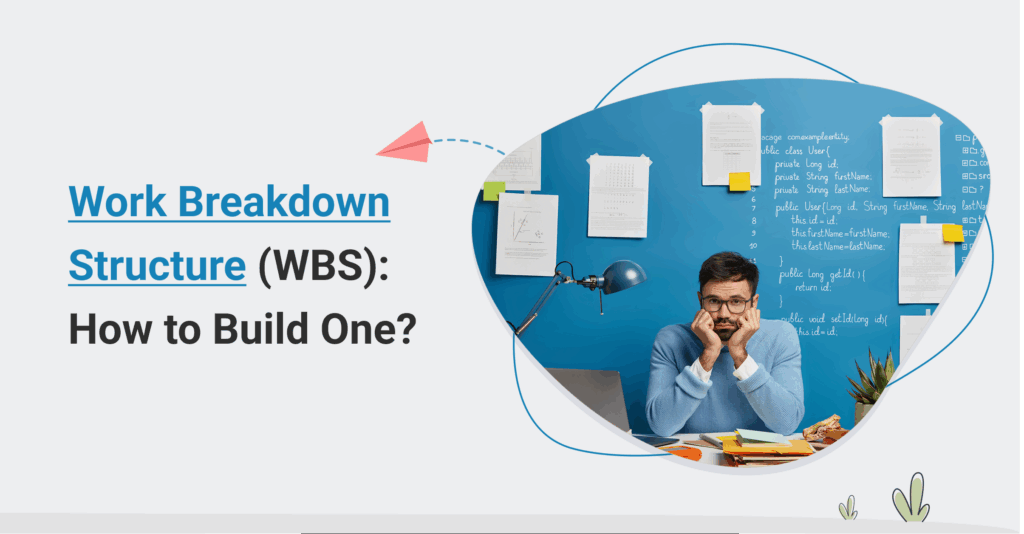Table of Contents
Work Breakdown Structure (WBS): Templates, Examples & How to Build One That Works
A Work Breakdown Structure (WBS) is the foundational framework of any well-managed project. According to the Project Management Institute’s PMBOK® Guide, a WBS is “a hierarchical decomposition of the total scope of work to accomplish project objectives.” Think of it as a tree diagram that breaks down a complex project into smaller, digestible work packages.
In project management platforms, a WBS maps naturally to the task → subtask → deliverable structure, helping teams visualize effort, assign ownership, and prevent scope creep. In contrast to a simple to-do list, a WBS builds logical dependencies, enabling better forecasting and progress tracking across teams and timelines.
As PMI researchers Brotherton, Fried and Norman note, “The WBS is a foundational building block to initiating, planning, executing, and monitoring and controlling processes that are used to manage projects.”
WBS is where scope clarity begins and budget overruns are prevented.
What Are The Key Components of a WBS?
A well-structured Work Breakdown Structure (WBS) includes three primary layers that mirror how real projects are delivered in project management tools:
Project Phases (Level 1)
These are high-level groupings like:
- Planning
- Design
- Development
- Testing
- Launch
Purpose of this phase: Organize the timeline and resource allocation by lifecycle stage.
Deliverables (Level 2)
Each phase includes deliverables and tangible outcomes like “Wireframes Completed” or “MVP Released.”
Purpose of this phase: Make progress measurable and outcome-based.
Work Packages (Level 3)
Work packages are the smallest elements of a WBS, comprising discrete, executable tasks assigned to individual contributors.
Purpose of this phase: Certify accountability, duration estimation, and dependency mapping.
💡 Pro Tip: Visualize your WBS using Avaza’s Gantt + Kanban view
How to Build a Work Breakdown Structure Step-by-Step
The best way to create a Work Breakdown Structure (WBS) is by following a structured, top-down process that scales with project complexity. Below is a five step approach used by certified project managers and product teams alike.
1. Start with the Project Objective
Write a one‑sentence outcome that captures why the project exists. This becomes Level 1 of your WBS.
Example: “Launch SaaS Platform V2 for 10 k active users.”
💡 In Avaza: Create a new project and paste the objective as the Project Name. Every view, Tasks, Dashboards, Gantt Chart, will now align to that single goal.
2. Break Objectives into Major Deliverables
Ask, “What finished things prove the project is done?” List 4–6 concrete nouns; these form Level 2.
Example Deliverables: New UI Design, Backend API Upgrade, Email Onboarding Funnel, Go‑Live Support.
💡 In Avaza: Enter and organize each deliverable as a Task Group (parent task) & show them on Gantt charts so each deliverable instantly appears as a swim‑lane on the timeline.
3. Break Each Deliverable into Work Packages
Decompose every deliverable into chunks that take 8–40 hours. If a package is larger, split it again—these nodes form Level 3.
Example: Under “New UI Design,” add Wireframes, Hi‑Fi Mock‑ups, Design System Docs.
💡 In Avaza: Add each package as a Subtask. Use the Estimated Hours field to enforce the 8–40 h rule; Avaza auto‑sums estimates up the hierarchy.
4. Assign One Owner per Work Package
Give every lowest‑level node a single accountable owner: name, role, or vendor.
💡 In Avaza: Open the subtask and choose an assignee via the Assign Task dropdown. Then switch your board to Group by Assignee using the Task List grouping options; you’ll see real‑time workload balance.
5. Validate the Structure
Run a quick checklist:
- Does the WBS capture 100 % of scope?
- Any overlaps or gaps?
- Do owners accept the estimates?
💡 In Avaza:
- Jump to the Gantt Chart view to spot timeline holes.
- Open the Project Summary to confirm total estimated hours vs. team capacity.
- Link tasks with Dependencies; Avaza flags circular or missing links automatically.
Your WBS is now live, fully linked to estimates, owners, and a dynamic schedule. No manual rebuilds, just plug‑and‑play execution.
What Tools Can Help Me Build a WBS?
There’s no shortage of tools that let you build a Work Breakdown Structure, but only a few translate it into actual project velocity. Below is a breakdown of the leading options and how they fit different project types.
Tool | Best For | Visual WBS | Task Linking | Gantt Integration | Pricing Tier |
End-to-end PM for Teams | ✅ Subtasks & Gantt | ✅ Native | ✅ Auto-schedule | ||
MS Project | Enterprise PMs | ✅ Tree | ✅ Complex | ✅ Yes | Paid only |
Lucidchart | WBS Visualization | ✅ Diagrams | ❌ Static only | ❌ | Paid |
ClickUp | General Task Breakdown | ✅ Docs & Lists | ✅ Yes | ✅ Yes (limited) | Free + Paid |
Excel / Sheets | Budget-strapped Orgs | ❌ Manual | ❌ | ❌ Manual | Free |
How Avaza Makes WBS Visual and Actionable?
In Avaza, you can build and view your WBS in multiple visual formats, each designed to fit different thinking and planning styles.
Visual WBS Building in Avaza: Supported Views
View Type | WBS Advantage |
Ideal for rapid structuring of phases → deliverables → subtasks | |
Perfect for visualizing WBS progress by status or workstream | |
Aligns work packages with timelines and dependencies | |
Provides real-time visibility of upcoming task deadlines | |
Timeline Drag | Lets you shift or restructure WBS nodes without breaking logic |
All views are synced, meaning updates in one are reflected across all with no manual syncing needed.
Can I Turn My WBS Into Timelines And Tasks In Avaza?
Yes, in Avaza, your Work Breakdown Structure isn’t just for planning. It’s the launchpad for execution. Each phase and deliverable you outline in your WBS can be converted into scheduled tasks and visualized in a timeline with just a few clicks.
From WBS to Timeline: How It Works in Avaza
- Create your WBS in List or Kanban view: Start by outlining your project’s hierarchy, like, “Phase → Deliverable → Task.”
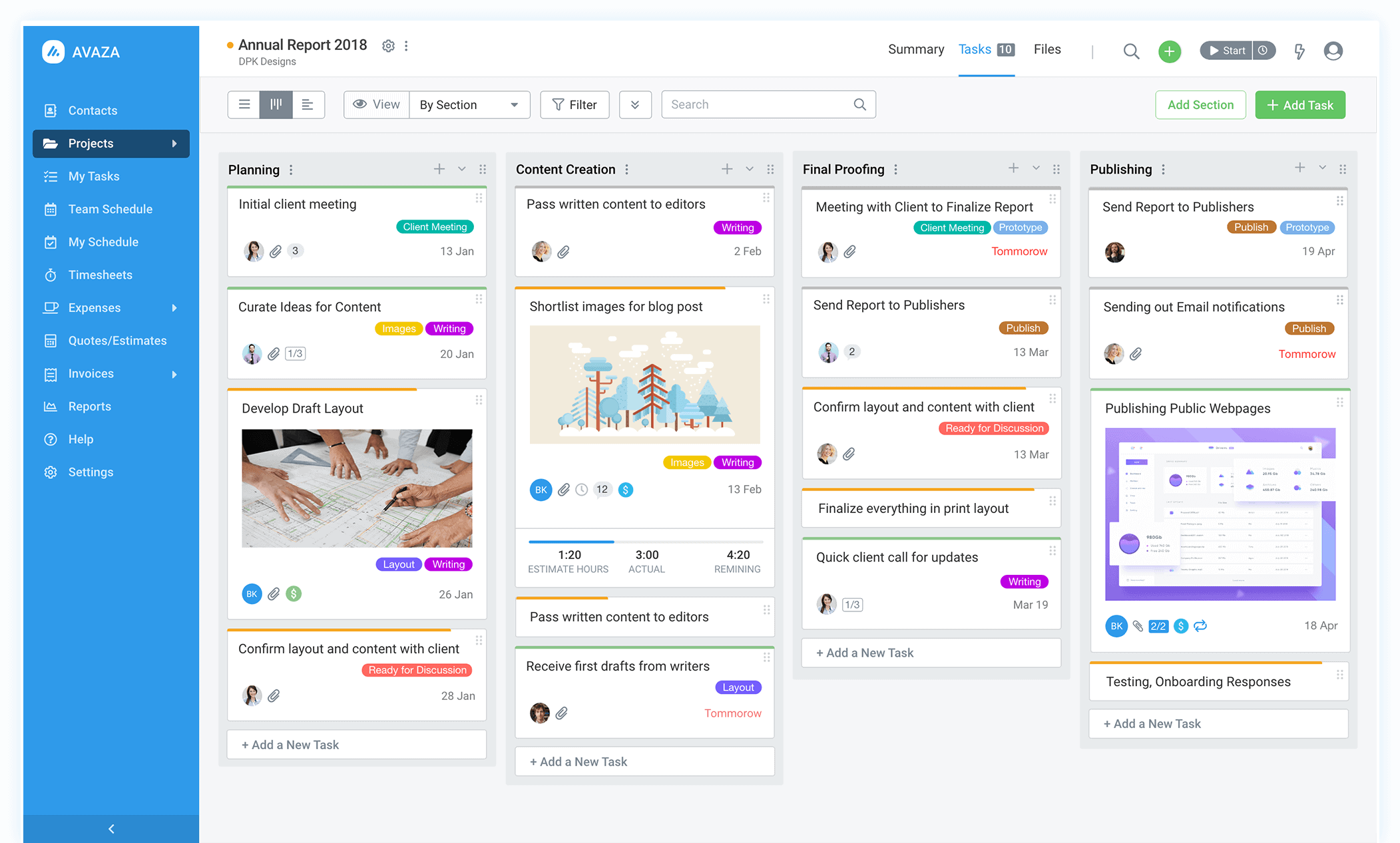
- Assign owners and due dates: Add assignees, set deadlines, and estimate effort directly in the task panel.
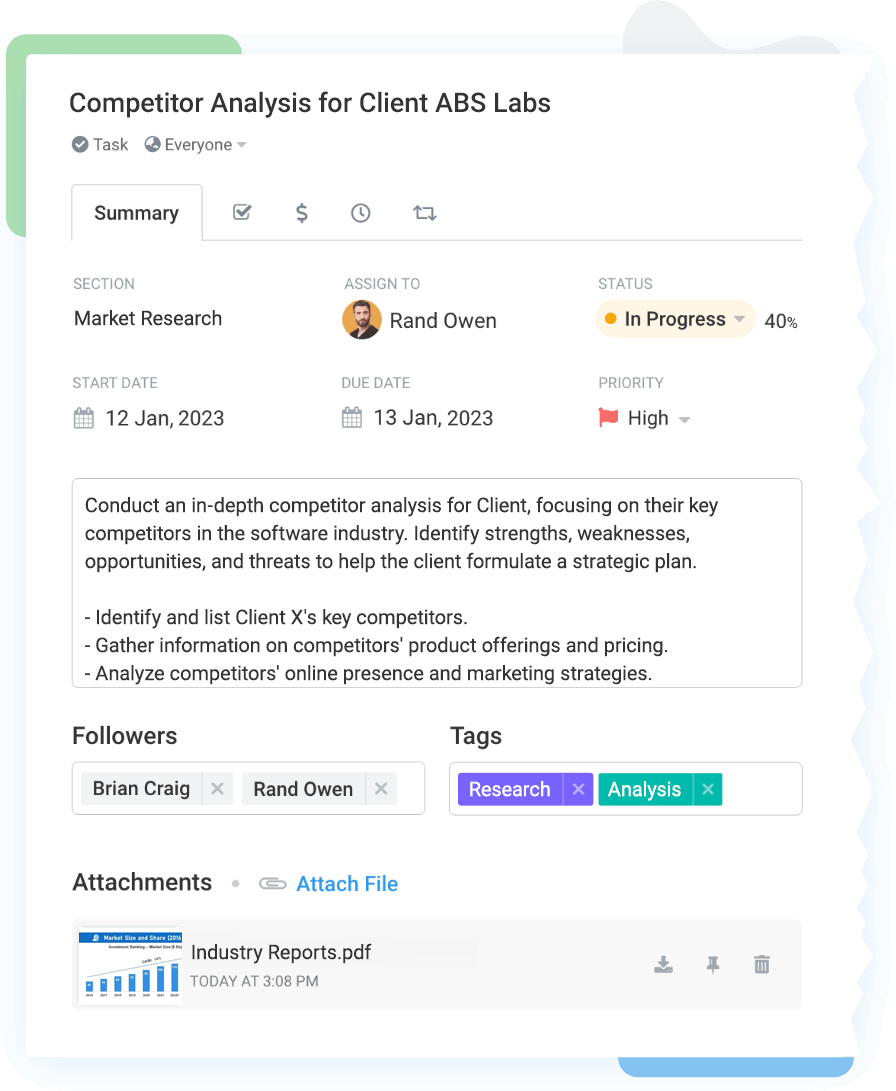
- Switch to Gantt View: Watch your WBS auto-convert into a timeline with drag-and-drop bars, dependencies, and milestone markers.
- Adjust with auto-scheduling: Shift one task, and all dependent items realign (without breaking logic).
“It was very user friendly and easy to get started. I especially liked the variety of visual formats, as I like lists and my partner likes Gantt charts.”
— Amy N., Co-owner (Non-Profit), verified review on Capterra
How Does Avaza Help With Team Accountability and Task Assignment?
Avaza turns your WBS from abstract structure into actionable responsibility, right down to the person. With native support for role-based assignments, time tracking, and real-time task visibility, your team doesn’t just see the project, they own it.
How Avaza Builds Accountability Into Every Task
- Multi-assignee support: Assign tasks to one or more team members, each with their own hours, deadlines, and comments.
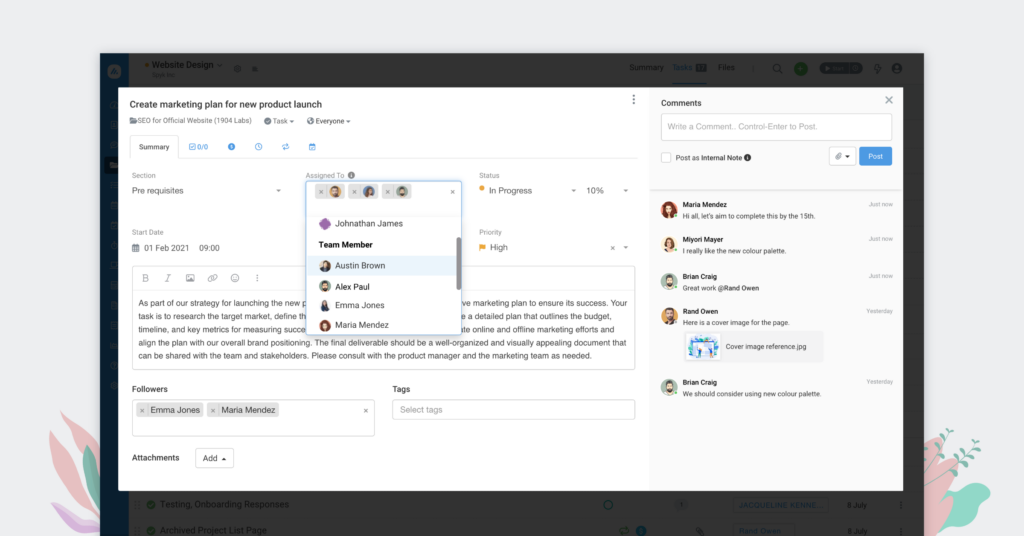
- Effort-based tracking: Set estimated hours per subtask. As work is logged, progress is automatically visualized.
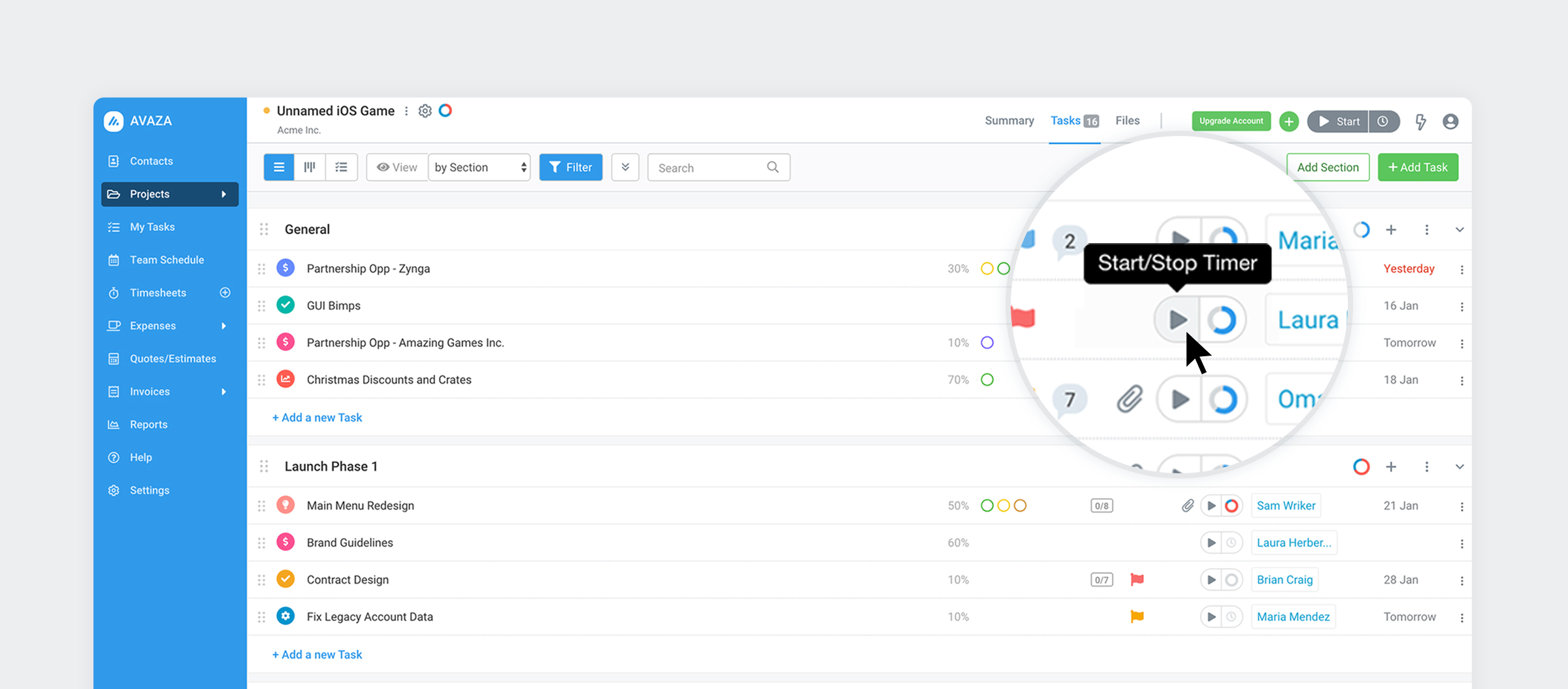
- Activity feed + comment history: No need to chase status in Slack. Everything’s logged in the task card, visible to collaborators.
- @Mention + Notification engine: Keeps teams looped in without micromanagement.
“With Avaza, we can create tasks, assign them to team members, and keep track of who has done what, all on one screen.”
— Anu C., HR Consultant, G2 review
WBS Templates: Google Spreadsheets
If you’re new to Work Breakdown Structures, starting from a blank screen can stall your progress. Instead, use one of the following free WBS starter templates below to get moving quickly.
Template Name | Format | Best For |
Google Sheets | Professional Services Firms (overall) | |
Google Sheets | Marketing + Dev Collaboration | |
Google Sheets | Client Projects | |
Google Sheets | Agile Backlogs | |
Google Sheets | Internal Ops + Logistics |
Can I Automate WBS Creation With Avaza Templates?
Yes, with Avaza’s reusable project templates, you can automate your WBS setup in seconds.
Instead of building every breakdown from scratch, Avaza lets you clone full project structures, including:
- Tasks
- Subtasks
- Dependencies
- Assignees
This is especially useful for agencies, dev teams, and consultants managing recurring deliverables or similar client scopes.
How Avaza’s Templates Automate Your WBS?
- Prebuilt task hierarchies: Start with nested tasks already structured by phase, deliverable, and work package.
- Role-based auto-assignment: Assign work automatically to roles (e.g., “Designer,” “Dev Lead”), not just individuals (great for dynamic teams).
- Time and effort presets: Include estimated hours or durations in templates to accelerate scheduling.
- Template library management: Save, update, or fork templates as your PM playbook evolves.
Can I Reuse WBS Templates Across Projects?
Yes, a reusable WBS template is a strategic asset, not just a convenience. In Avaza, you can convert any completed project into a template, preserving its structure, roles, and task logic. This is especially useful for agencies, SaaS teams, or consulting firms that run repeatable delivery models.
When Template Reuse Is Most Effective
- Recurring engagements (e.g. monthly SEO campaigns, feature sprints)
- Cross-client consistency (for agencies with standardized service tiers)
- Onboarding programs (structured checklists for HR or customer success)
- Time-to-value acceleration (skip the structural build and get right to scheduling)
WBS Examples for Different Industries
In this section, we’ll discuss how does WBS structure looks like in the following industries:
- Construction
- Software Development
- Creative Agencies
- Engineering Project Workflows
What does a WBS look like for a construction project?
In the construction industry, a Work Breakdown Structure (WBS) helps in translating large, multi-phase builds into clear, accountable work packages. Whether organized by project phase (e.g., pre-construction, build, closeout) or by deliverable/component (e.g., foundation, framing, electrical), a well-structured WBS clarifies the entire project scope, helping teams estimate costs, create schedules, assign crews, and ensure regulatory compliance.
Construction managers typically use both phase-based and deliverable-oriented WBS formats, depending on the project’s complexity and stakeholder needs. No matter the approach, the WBS must always reflect 100% of the project scope i.e., from permitting and staging to inspections and finishes.
Here’s an example WBS for a commercial office building:
Phase | Deliverable | Task |
1. Pre-Construction | Site Survey & Permits | Obtain zoning clearance, order soil tests |
2. Structural Build | Foundation Completed | Excavate, pour concrete, cure slab |
3. Vertical Framing | Framing Installed | Steel beam delivery, frame welding |
4. Safety & Compliance | Final OSHA Approval | Schedule inspector, submit logs |
5. Closeout | Occupancy Certificate | Final walkthrough, submit punch list |
How Does WBS Work In Software Development?
A software WBS breaks technical complexity into feature-first groupings that are easy to assign, estimate, and test. A Gantt or backlog alone focuses on time sequencing, whereas the WBS reflects delivery logic.
In practice, IT WBS often include work like “Requirements Analysis,” “Architecture,” “Development,” “Testing,” and “Deployment,” with tasks under each package. The key is to capture all deliverables (code modules, documentation, infrastructure setup) and their subordinate tasks to make sure nothing is missed
Here’s an example for a SaaS user onboarding module:
Feature Set | Submodule | Task |
1. Account Creation | Email Verification | Build endpoint, write test, deploy flow |
2. UI Onboarding | Welcome Tour UI | Design layout, hook tooltips, QA in staging |
3. Analytics Setup | User Funnel Events | Add tracking calls, define events in GA4 |
4. Access Controls | Role Permissions | Role schema design, permission testing |
Can Creative Agencies Use WBS For Campaigns?
Many creative agencies adopt WBS models to align campaign workflows across strategy, production, and delivery teams. It helps bridge the gap between vision and execution, especially when managing multiple client feedback loops and deadlines.
Example WBS for a launch campaign for a new product:
Campaign Phase | Deliverable | Task |
1. Creative Brief | Messaging Framework | Draft key messages, client review |
2. Asset Production | Social + Web Assets | Create Figma mockups, export final files |
3. Media Planning | Channel Calendar | Map timing across email, socials |
4. Launch & QA | Scheduled Asset Drops | Upload to CMS, QA links |
5. Post-launch | Campaign Report | Pull metrics, annotate results |
Is There A WBS For Engineering Project Workflows?
Yes , WBS is widely used in engineering to deconstruct complex systems into measurable, testable components. From mechanical to systems engineering, a strong WBS ensures procurement, design, and validation are fully scoped from day one.
Here’s a WBS example for an automated conveyor belt system:
Phase | Subsystem | Work Package |
1. Mechanical Design | Roller Assembly | CAD model, materials spec, prototype |
2. Electrical System | Control Board | Circuit design, PCB fab, safety test |
3. Software Layer | Logic Controller Code | Firmware dev, integration with sensors |
4. Procurement | Vendor Selection | RFP creation, bid review, PO issuance |
5. QA & Validation | Load Testing | Bench test, stress protocol, report |
How Does WBS Differ In Product Vs. Service Projects?
Work breakdown structures may look similar on paper but, product-based vs. service-based WBS models require fundamentally different approaches to scope, delivery, and repeatability.
Here’s how they compare:
Dimension | Product-Based WBS | Service-Based WBS |
Outputs | Physical or digital deliverables | Activities, milestones, outcomes |
Scope Repeatability | Often modular and reused across SKUs | Varies by client or engagement |
Phases | R&D → Prototyping → QA → Launch | Discovery → Delivery → Optimization |
Example Deliverables | Hardware design, app release, feature set | Training, onboarding, consulting workshops |
Task Modularity | BOM-based, tied to specs | Outcome-based, tied to SLAs or OKRs |
Best Practice Tip | Anchor around component hierarchies | Anchor around client touchpoints and goals |
How Does WBS Compare To Task Lists?
At a glance, a task list and a Work Breakdown Structure (WBS) may look similar as they both contain things to do. But they serve distinct functions in project management.
- The WBS structures what must be delivered.
- A task list sequences how to act on it.
Here’s a visual breakdown:
Feature | WBS | Task List |
Purpose | Define the full scope of deliverables | Track tasks for team execution |
Structure | Hierarchical (tree or outline) | Flat or sequential list |
Dependencies | Not shown (handled in Gantt or separate logic layer) | Rarely captured |
Use Case | Scope planning, stakeholder alignment | Daily team execution, micro-tracking |
Avaza Example | Use subtasks within projects to build hierarchy | Use Kanban board to check progress on tasks |
What’s The Difference Between WBS and Gantt Charts?
- A Work Breakdown Structure (WBS) shows what needs to be delivered.
- A Gantt chart shows when and how long each activity takes.
They’re complimentary, not interchangeable.
Here’s a direct comparison:
Feature | WBS | Gantt Chart |
Focus | Scope & deliverables hierarchy | Time-based scheduling & sequencing |
Visual Format | Tree diagram or nested list | Horizontal bar timeline |
Dependencies | Not shown; defined separately | Explicit task dependencies, lead/lag timing |
Usage Stage | Project scoping & planning | Execution & time tracking |
Avaza Application | Use subtasks and milestones | Auto-schedule tasks with Gantt dependencies |
If you try to build a Gantt before you’ve structured your WBS, you risk misestimating both effort and scope. Think of WBS as your architectural blueprint. Gantt is your construction schedule.
What is a Functional Breakdown Structure Vs WBS?
- A Functional Breakdown Structure (FBS) organizes a project by department or function (e.g., engineering, marketing, QA).
- A Work Breakdown Structure (WBS) organizes it by what needs to be delivered, regardless of who does it.
This distinction matters when managing cross-functional SaaS or product teams.
Criteria | WBS (Work Breakdown Structure) | FBS (Functional Breakdown Structure) |
Breakdown Basis | Deliverables and sub-deliverables | Departments or business functions |
PMO Focus | Scope clarity, timeline planning | Team allocation, budgeting |
Ownership Alignment | Across outputs or customer-facing results | Aligned to internal roles/org chart |
Best Used When | Project success is deliverable-defined | Functional performance or cost-center analysis is key |
Avaza Usage Scenario | Plan deliverables using subtasks + milestones | Filter by team role or department for assignment breakdown |
Use both structures when:
- Working in matrix orgs
- Running multi-team projects with siloed deliverables
- Tracking scope vs. accountability in parallel
Top-Down Vs Bottom-Up WBS: Which To Choose?
Building a Work Breakdown Structure (WBS) can follow either a top-down or bottom-up approach. Each method influences collaboration, accuracy, and control.
Approach | Top-down WBS | Bottom-up WBS |
Initiated By | Project manager or leadership | Functional team members or contributors |
Ideal For | High-level scoping, rapid alignment | Ground-truth tasking, detailed planning |
Risk | May overlook on-the-ground complexity | May lack strategic cohesion if unguided |
Use Case | Waterfall projects, predefined scope | Agile teams, cross-functional SaaS launches |
💡 Avaza Tip | Use top-down for milestones, then layer bottom-up tasks | Use subtasks to allow team-input via Kanban or Timeline view |
When to use each approach:
- Use top-down if: You need to align execs first or present to stakeholders.
- Use bottom-up if: Your team owns execution and needs to vet the plan.
- Use hybrid if: You’re running a cross-functional roadmap or MVP sprint.
Can WBS Be Used In Agile Project Teams?
Yes, WBS can absolutely work within Agile teams, especially when adapted into a modular, sprint-aligned structure. The key is flexibility, which means using WBS to define deliverable scope, not to lock timelines.
How WBS adapts to Agile:
- Use epics and features as top-level deliverables
- Break into user stories or tasks as work packages
- Map to sprint cycles using subtasks in tools like Avaza’s Kanban or Timeline view
- Keep the structure lightweight to flex during retrospectives
Hybrid WBS Example:
WBS Layer | Agile Equivalent |
Phase: MVP Launch | Sprint 0-1 |
Deliverable: Signup UX | Epic |
Task: Validate CTA | Story / Task |
Why this works:
- Stakeholders get a structured scope view
- Teams maintain iteration speed
- PMs can sync WBS with burn-down velocity and cycle times
WBS Vs. Related Breakdown Structures
In complex projects, multiple breakdown structures are used in tandem. Each serves a different planning need i.e., scope, resource, responsibility, or deliverables. A Work Breakdown Structure (WBS) should not be confused with PBS, RBS, or OBS as each has a distinct logic and focus.
Breakdown Structure Comparison Matrix
Structure | Primary Focus | Answers the Question | Hierarchy Based On | Main Use Case |
WBS | Work/Tasks | “What work needs to be done?” | Deliverables → Work Packages | Scope planning, task management |
PBS | Products/Deliverables | “What are we building?” | Products → Subcomponents | Scope definition, especially in PRINCE2 |
RBS | Resources (people/tools) | “What do we need to do the work?” | Labor, tools, cost units | Budgeting, resource allocation |
OBS | Organizational Roles | “Who is responsible?” | Departments → Roles | Role assignment, performance tracking |
When to Use Each Structure:
- Start with PBS to define scope clearly.
- Develop WBS to organize execution.
- Add OBS to assign responsibility.
- Use RBS to plan resources and budget.
This modular stack makes sure project plans are complete, resourced, and owned i.e., from outcomes to actions to accountability.
WBS Vs. RBS (Resource Breakdown Structure)
A Work Breakdown Structure (WBS) outlines what needs to be done in a project by breaking the scope into tasks, sub-tasks, and deliverables. In contrast, a Resource Breakdown Structure (RBS) outlines who or what will do the work by breaking resources into people, equipment, or skill categories.
The RBS supports cost estimation, resource allocation, and risk management by grouping resources into structured categories (e.g., “Design Team,” “Software Tools,” “Hardware Assets”).
Key Differences
Feature | WBS | RBS |
Focus | Tasks & Deliverables | People, Tools, Budget Units |
Primary Use | Scope definition, scheduling | Cost planning, resource tracking |
Hierarchy Structure | Based on work packages | Based on resource categories |
Example Top Node | “Develop Website” | “Creative Resources” |
Typical Output | Gantt Chart, Task List | Resource Pool, Budget Allocation Plan |
WBS Vs. PBS (Product Breakdown Structure)
While a Work Breakdown Structure (WBS) answers “How will we deliver the project?”, a Product Breakdown Structure (PBS) answers “What are we delivering?”. The two are complementary, not interchangeable.
Side-by-Side Comparison
Feature | PBS (Product Breakdown Structure) | WBS (Work Breakdown Structure) |
Focus | What is being delivered | How the work will be executed |
Primary Use | Scope definition, outcome mapping | Task management, effort planning |
Hierarchy Structure | Based on deliverables and subcomponents | Based on work packages and tasks |
Example Node | “Mobile App” → “UI Module,” “Backend API” | “Design UI,” “Develop API,” “Test Features” |
Used In | PRINCE2, systems engineering, hardware delivery | PMBOK, Agile, traditional project planning |
WBS Vs. OBS (Organizational Breakdown Structure)
A Work Breakdown Structure (WBS) defines what needs to be done. An Organizational Breakdown Structure (OBS) defines who is responsible for doing it. These two frameworks complement each other, especially in large or matrixed teams where role clarity and accountability are critical.
The OBS is often visualized like an org chart by breaking the organization down into departments, teams, or individuals. According to Upland Software, the OBS “provides a view of the project to upper management, showing which unit is responsible for each deliverable.” The WBS, meanwhile, “captures every component of the project from a task and scope standpoint.”
Key Distinctions
- WBS = Task hierarchy
- OBS = Role hierarchy
- WBS answers: “What must be done?”
- OBS answers: “Who is doing it?”
Real-World Example
Let’s say your WBS includes a work package: “Create Ad Assets”
- In the OBS, that maps to:
- Marketing Department → Creative Team
- Responsible Role: Senior Designer
This mapping allows project managers to:
- Assign ownership per work package
- Track performance by team or department
- Align capacity with task complexity
- Report progress to leadership by organizational unit
Best WBS Practices for Hybrid and Agile Projects
Here are six WBS best practices for Agile/hybrid workflows:
- Start with high-level structure: Create a WBS that organizes epics by feature, capability, or value stream.
- Feed the backlog: Use your WBS output to build your product backlog by bridging scope planning with iterative work.
- Apply the 100% Rule: Every WBS level must account for 100% of its parent task. This ensures nothing slips through.
- Enforce task exclusivity: Tasks should be mutually exclusive to avoid rework and duplication.
- Run collaborative breakdowns: Include your team or agile squad when creating the WBS (just like sprint planning sessions).
- Hybrid Split Approach: Use a phase-oriented WBS for project-level tracking and a feature-oriented WBS for deliverables and sprint-level detail.
Common WBS Mistakes: Why Do WBS Structures Often Fail In Real Projects?
Work Breakdown Structures (WBS) fail not because of the framework but due to how they’re applied in practice. The biggest pitfalls stem from unclear scope, siloed teams, and static documentation.
Top reasons WBS structures break down:
- Vague deliverables → Without clearly defined outputs, teams misinterpret scope.
- No stakeholder alignment → If your WBS skips a review loop with leads, assumptions multiply.
- Overloaded top-down planning → Centralized control often overlooks team-level constraints.
- Static WBS files → Building your WBS in Excel or PDF creates a stale artifact, not a living system.
- Disconnected from execution tools → If your WBS doesn’t integrate with your task and resource layers (e.g., Avaza), it gets ignored.
FAQs
What mistakes do project managers make when building a WBS?
Common WBS mistakes include vague task names, flat structures, excessive granularity, and missing ownership. Instead, use noun-based deliverables, break work into visual levels (phases → deliverables → packages), and aim for 8–40 hour work units. Sync your WBS with tools like Avaza to keep it alive post-kickoff. Assign a clear owner for each work package to withhold accountability.
How detailed should my WBS be?
A WBS should be specific enough to guide effort but not so granular it causes friction. Use the 8–40 hour rule for task sizing, group micro-tasks under clear deliverables, and assign roles at the lowest level. If an item is too vague or too massive, break it down. If it’s under an hour, roll it up.
Can WBS work for marketing or non-traditional projects?
Yes, WBS is useful for campaigns, creative work, and non-technical projects. Just shift from engineering-style outputs to strategic phases and content deliverables. For example, a marketing WBS may include phases like Planning, Content Production, Launch, and Analytics, with work packages like “Script Video” or “Schedule Email.” Creative agencies use WBS to assign roles, track revisions, and prevent rework.
How is a WBS different from a schedule?
A WBS defines what work is required (organized by scope, not time). A schedule (like a Gantt chart) defines when that work happens. The WBS is hierarchical and deliverable-focused, whereas, the schedule is linear and time-sequenced. A task list is flat and used for daily execution. Tools like Avaza let you build your WBS first, then convert it into a timeline without duplication.
When in a project should I build a WBS?
Create your WBS during the planning phase, right after project initiation and before schedule development. In the project lifecycle, scoping begins in initiation, but the WBS takes shape during planning. This structure defines what you’ll build before asking when or how fast. Use Avaza to map task groups early and structure your project before timelines enter the picture.
What’s Next After Building The WBS?
Once your WBS is complete, the next step is turning that structure into a living, scheduled, and resourced plan. Here’s how to move from breakdown to execution:
- Map Work Packages to Tasks: Each leaf node in your WBS becomes an actionable task in Avaza. Use Kanban or list views to organize by owner or sprint.
- Assign Owners & Due Dates: Use Avaza’s resource scheduler to allocate hours and assign team members. Real-time availability prevents overbooking.
- Auto-schedule with Dependencies: With the Gantt view, Avaza automatically reflects dependencies. Adjust one task’s timeline, and connected items shift.
- Track Progress Visually: View project health through dashboards. Color-coded status indicators keep stakeholders aligned without micromanaging.
- Iterate Weekly: In agile or hybrid environments, revisit your WBS structure in sprint retros. The breakdown evolves as scope does.
▶️ Start Free WIth Avaza TODAY— build it, staff it, ship it.
